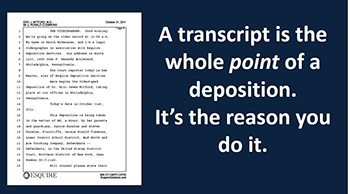
Transcripts make great teachers
My first deposition seemed to go pretty well. It was 17 years ago. I left the room feeling good about how I handled a hostile witness.

But when I read through the transcript a few days later, I cringed a bit. I hadn’t done quite as well as I initially thought. The questions I asked the witness weren’t as artful as I imagined, the witness’ admissions weren’t as damning, and my verbal tics were on the page for the world to read.
I didn’t realize these issues during the deposition, but I sure couldn’t ignore them in the transcript. There were definitely times during that deposition that I could have used a mulligan.
Every attorney I know has had a similar experience. In retrospect, it was a rite of passage we all could have avoided. I would have learned a lot from a practice deposition – by deposing a mock witness with a real court reporter in the room. I could have reviewed the transcript before I took a real deposition.
Give young lawyers a hand(out)
With that said, attorneys do get trained in taking depositions. As a longtime litigator, I’ve trained many new associates and law students in the practice. My colleagues and I used mock case files for the young lawyers, brought them into conference rooms, and then watched them take or defend a “deposition.”
After, we’d gently critique the attorneys’ performances. Perhaps they should have adhered to the classic funnel questioning technique. Maybe they should have followed up on the witness’s answer instead of forging ahead to the next topic. Or stopped saying “all right” every 20 seconds.
The associates took our critiques to heart, but they had nothing to take home with them at the end of their session except a jostled ego and a few tips. Although they eventually improved, their learning would have been so much more rapid and effective with a transcript from their training session.
Four reasons to use a written transcript for training
First, a transcript would have given trainees a concrete way to understand their performance. Second, it would have given them something to take home and study (a handout, if you will). Third, a transcript would have better engaged associates who learn chiefly by reading words, of whom there are many in this profession. Fourth and most importantly, a transcript is the whole point of a deposition. It’s the reason you do it. You’ll use the transcript in motions and to impeach a witness at trial. It’s where the rubber meets the road. So why don’t we use transcripts in training?
I say we should. Let your associates cringe in practice, not when it counts.
Train on technology, too
While we’re discussing the value of realistic training, I’d also like to see more law firms and schools training attorneys on the technology they’ll see when they start litigating, including real-time transcription, remote deposition technology, and electronic exhibits.
The technology isn’t difficult – in fact, it’s intuitive for today’s digital natives. But it’s valuable to get a feel for it and to understand all the tricks you can do with it before you encounter it in a real case. Don’t let your opponent beat you to the punch.
Practice
It doesn’t always make perfect, but practice is more effective when it simulates the real-life experience you’re trying to master. Thus, I’d argue that deposition training should include a) finished transcripts to take home and study, and b) hands-on exposure to the technologies you’ll be using sooner rather than later.
If you haven’t practiced with the real tools and products, you’ve only scratching the surface of an effective training program.
